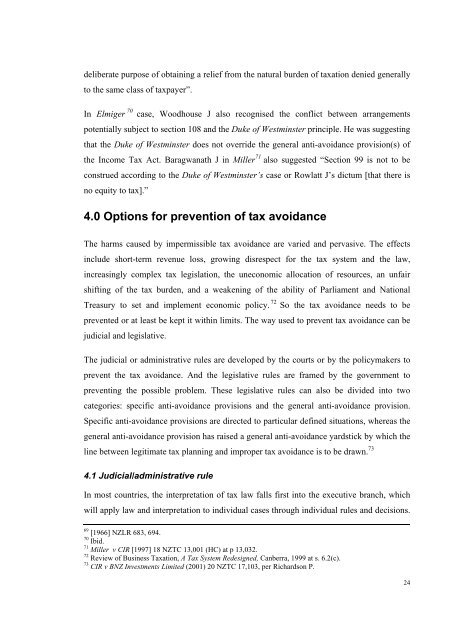Tax Avoidance: Causes and Solutions - Scholarly Commons Home
Tax Avoidance: Causes and Solutions - Scholarly Commons Home
Tax Avoidance: Causes and Solutions - Scholarly Commons Home
Create successful ePaper yourself
Turn your PDF publications into a flip-book with our unique Google optimized e-Paper software.
deliberate purpose of obtaining a relief from the natural burden of taxation denied generally<br />
to the same class of taxpayer”.<br />
In Elmiger 70 case, Woodhouse J also recognised the conflict between arrangements<br />
potentially subject to section 108 <strong>and</strong> the Duke of Westminster principle. He was suggesting<br />
that the Duke of Westminster does not override the general anti-avoidance provision(s) of<br />
the Income <strong>Tax</strong> Act. Baragwanath J in Miller 71 also suggested “Section 99 is not to be<br />
construed according to the Duke of Westminster’s case or Rowlatt J’s dictum [that there is<br />
no equity to tax].”<br />
4.0 Options for prevention of tax avoidance<br />
The harms caused by impermissible tax avoidance are varied <strong>and</strong> pervasive. The effects<br />
include short-term revenue loss, growing disrespect for the tax system <strong>and</strong> the law,<br />
increasingly complex tax legislation, the uneconomic allocation of resources, an unfair<br />
shifting of the tax burden, <strong>and</strong> a weakening of the ability of Parliament <strong>and</strong> National<br />
Treasury to set <strong>and</strong> implement economic policy. 72 So the tax avoidance needs to be<br />
prevented or at least be kept it within limits. The way used to prevent tax avoidance can be<br />
judicial <strong>and</strong> legislative.<br />
The judicial or administrative rules are developed by the courts or by the policymakers to<br />
prevent the tax avoidance. And the legislative rules are framed by the government to<br />
preventing the possible problem. These legislative rules can also be divided into two<br />
categories: specific anti-avoidance provisions <strong>and</strong> the general anti-avoidance provision.<br />
Specific anti-avoidance provisions are directed to particular defined situations, whereas the<br />
general anti-avoidance provision has raised a general anti-avoidance yardstick by which the<br />
line between legitimate tax planning <strong>and</strong> improper tax avoidance is to be drawn. 73<br />
4.1 Judicial/administrative rule<br />
In most countries, the interpretation of tax law falls first into the executive branch, which<br />
will apply law <strong>and</strong> interpretation to individual cases through individual rules <strong>and</strong> decisions.<br />
69<br />
[1966] NZLR 683, 694.<br />
70<br />
Ibid.<br />
71<br />
Miller v CIR [1997] 18 NZTC 13,001 (HC) at p 13,032.<br />
72<br />
Review of Business <strong>Tax</strong>ation, A <strong>Tax</strong> System Redesigned, Canberra, 1999 at s. 6.2(c).<br />
73<br />
CIR v BNZ Investments Limited (2001) 20 NZTC 17,103, per Richardson P.<br />
24

















